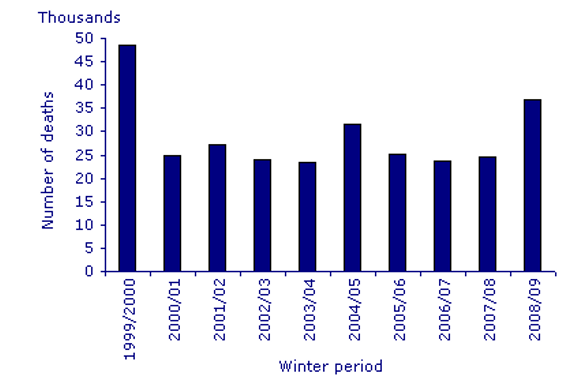Literature Review
The flu is a disease that is prevalent throughout the entire world and particularly in humid regions. The flu is not life threatening but deaths can result from pneumonia, worsening cardiopulmonary conditions and several other chronic diseases. Most affected are children, people with health problems and the aged (65 years and above) but most deaths i.e. over 90% are of the aged (Atkinson, Hamborsky& McIntyre, 2007). Yearly, it is estimated that there are up to 500 million flu-infected people with the severe cases being between 3 to 5 million (World Health Organization, 2003). Of these, it is estimated that 500,000 result in death.
In the United States of America, statistics indicate that we have over 200,000 cases of patients being admitted in the hospitals as a result of flu and over 36,000 people die annually due to flu. The flu spreads quite fast in favorable conditions, as was the case in 1918 when there occurred an outbreak of the Spanish influenza in the U.S. that saw 500,000 people die. In the world that year, 40 million people died from this flu. Cases of the flu increase during the cold weather. I”n England and Wales for example, there occurred an estimated 36,700 (49%) more deaths in the winter period of than in the non-winter period (2008/09) than in the previous year”( World Health Organization, 2003,p. 2). This increase in deaths was partly attributed to the increase in flu infections. The old people accounted for most of the deaths (Charlton& Murphy, 2010).
Winter Mortality

In Thailand, cases of flu infection increase drastically during the hot humid season (April to August) and are lowest during the rainy season when there is less movement and interaction (Patz, Epstein, Burke & Balbus, 1996). Along the African coastline, cases of flu related deaths are higher than on the main land and this is worsened by the high levels of malnutrition experienced by the people.
Vitamins Reduce the Duration and Severity of Influenza
Vitamins improve the body’s immune system and thus aid faster recovery from the flu. Some of the vitamins important in improving the body’s immune response are vitamins A, B3, B6, C, D, and E.
The effectiveness of vitamin C in preventing and relieving the symptoms of the flu
In a technical training facility, 463 students of the ages 18-32 participated in a controlled study that was out to find if mega doses of Vitamin C relieved symptoms of the flu. Those of age 18-32 were in the control group while those of age 18-30 were in the test group. The cold and flu symptoms among the two groups were compared. Individuals who showed signs in the control grouping were treated using “pain relievers and decongestants” (Gorton &Jarvis, 2006, p.2). While patients who were in the analysis group were administered with of 1000 mg of Vitamin C dosage for the initial six hours and followed by three times everyday after that.
“It was established that after the administration of mega dose Vitamin C, flu and cold symptoms decreased by 85% by both severity and duration in the test group as compared to the control group” (Gorton &Jarvis, 2006, p. 4).
Vitamin D
In a recent scientific study, vitamin D has been shown to relieve the symptoms of the flu (Cannell et al, 2006). It serves as an important regulator of the responses of the immune system (Tavera-Mendoza & White, 2007). Vitamin D is used to produce steroid hormones one of which has an antibiotic effect. It increases the body’s production of anti-microbial peptides that eat away the cell walls of bacteria and viruses including that of the influenza virus. Vitamin D in addition puts a stop to the immune or invulnerable system from discharging a lot of inflammatory body cells that is” the chemokines and cytokines into infected lung tissue thus reducing flu related deaths”( Tavera-Mendoza & White, 2007, p.5). Once the body is infected by flu causing agents, it will draw vitamin D from its storage organs to curter for augmented requirements and therefore those with insufficiencies will take more time to recuperate.
Niacin
Niacin is important to the body for energy production as well as improving immunity. Niacin’s healing properties minimizes the risk of secondary infection. In a study out to find if niacin relieved symptoms of the flu, 500-2,000 mg/day was found to be well tolerated during times when the immune system is fighting the flu and was administered (Gorton & Jarvis, 2006). The doses were administered immediately the flu began.
Vitamin A
Vitamin A is important in maintaining mucosal surfaces and production of antibodies, antigens, and serum immunoglobulin and thus improving the body’s immunity helping it fight the influenza virus ensuring a faster recovery.
Vitamin B6
Several studies have shown that Vitamin B6 improves the immune system response when administered in moderate doses, as mega doses provide no additional benefits. This vitamin helps in the synthesis of white blood cells, which are major participants in cellular immunity.
Vitamin E
A study that had the daily dose of vitamin E increased in healthy subjects over 65 years from 30 mg (the recommended dietary allowance) to 200 mg was carried out. It showed that there was an increase in the antibody response to the flu infection.
References
Cannell, J., Vieth, R., Umhau, J., Holick, M., Grant, W., et al. (2006). Epidemic influenza and vitamin D. epidemiology and infection. Epidemiol Infect Review Journal, 134(6), 1-12.
Charlton, J. &Murphy, M. (2010).The health of adult Britain 1841-1994. British Medical Journal, 2(1), 205-216.
Gorton, H. & Jarvis, K. (2006).Vitamin C prevents and treats the common cold. Journal of manipulative and physiological therapeutics, 22(8), 1-3.
Patz, J., Epstein, P., Burke, T., Balbus. (1996). Global climate change and emerging infectious diseases. JAMA, 275(3), 217-223.
Tavera-Mendoza, L., & White J. (2007). Cell defenses and the sunshine vitamin. Scientific American, 2(1), 62-72.
World Health Organization. (2003).Guidelines for preventing influenza: Influenza in the Healthcare Setting. Washington, DC: Clark.